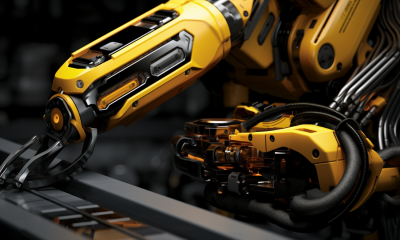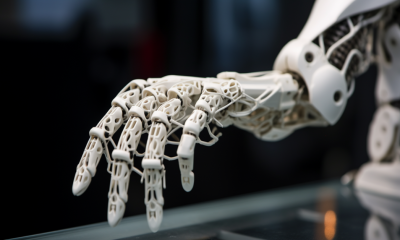Robotics
How Robotics Can Take a Cue From Nature
Securities.io is not an investment adviser, and this does not constitute investment advice, financial advice, or trading advice. Securities.io does not recommend that any security should be bought, sold, or held by you. Conduct your own due diligence and consult a financial adviser before making any investment decisions.

From being a source of amusement for science fiction writers to becoming a tool for development for human society, robots, and robotics have traveled a long distance.
Between 2016 and 2028, the global robotics market is expected to grow from nearly US$23 billion to more than US$45 billion. During its inception, robotics was thought of as something that would remain limited to industrial spaces.
On the contrary, more than half of the robotics market now comprises service robotics. Robots, these days, find wide use in the automotive industry, chemical industry, electric/electronic industry, food industry, medical industry, and more. More innovatively, robotics providers are ensuring its use in more traditional fields such as agriculture, domestic labor, and entertainment.
While it is true that robotics’ role has been transformative in many conventional fields, can it learn a thing or two from the world around us? Today, we will look closely at scenarios where robotics can take a cue from nature.
How Bio-Inspired Robotics Can Enrich Itself from Whirligig Beetles
Known as the world’s fastest-swimming insect, Whirligig beetles can attain an acceleration of 100 meters per second and a top velocity of 100 body lengths per second, or 1 meter per second, to be precise. But how do they achieve such speed and acceleration?
Their flying strategy was studied by researchers and published in the journal Current Biology. The study went by the title, ‘Whirligig Beetle Uses Lift-Based Thrust for Fastest Insect Swimming.’
The research deployed two high-speed cameras synchronized at different angles. The output was the video that detailed the flying mechanism: lift-based thrust. It worked similarly to a propeller, with the thrusting motion playing out perpendicular to the water surface. The mechanism helps eliminate drag and brings more momentum for greater speed.
Why is this finding important? While it is true that lift-based thrust was already identified in large-scale organisms, this study shows that the phenomenon applies to a length scale as low as 1 centimeter.
According to Chris Roh, Assistant Professor of Biological and Environmental Engineering in the College of Agriculture and Life Science, this discovery speaks to bio-inspired robotics and other engineering communities to first identify the right physics and then try to preserve that physics in creating the robotics.
More specifically, Roh believes this phenomenon can find use in developing uncrewed robotic ships, which can be much smaller and more flexible by leveraging the lift-generating propulsion mechanisms of whirligigs. The United States is in the process of developing such boats that will be free from the constraints of offering hospitality to the crew.
This research prompts us to see robotics in a new light. It is always possible to take cues from nature and reverse engineer them into human-mechanical designs. We have found some more examples of such synergy between nature/humans and the machine.
Octopus-Inspired Robot that Was Hailed as the Future of Soft Robotics
Created in 2016 by Cecilia Laschi, a professor at Sant’Anna’s BioRobotics Institute, Pisa, Italy, the Octopus-inspired robot was immensely flexible and could react to its environment with much more sensitivity and accuracy than most other soft robots that were developed till then. In Laschi’s words:
“This relatively new field of research has the potential to upend our ideas about what robots are capable of and where they can be useful.”
The robot that required far less computing power and was much more adept at moving on rough terrains could draw in liquid and then expel it from its body. It could scamper across the rough sea bed using all its eight legs.
The robot was built with electro-active polymers that contorted when exposed to electricity. The robot had its successful testing in the Mediterranean in early 2016. Its development has helped the field of soft robotics make much more progress since then.
In one instance, in 2017, Harvard University came up with the Octobot, a soft robot with all its mechanical components replaced with analogous soft systems. It was 3D-printed and had inlaid channels facilitating power and movement control, powered through gas-fueled pneumatics.
Apart from the octopus-inspired developments, the bio-inspired robotics mimicked other animals, too. The École Polytechnique Fédérale de Lausanne engineers, for example, developed a robot that mimicked a Salamander’s motion.
Another team of researchers drew inspiration from snakes. Owing to their properties of being able to traverse through complex and intricate terrains, these robots could prove useful in space exploration.
Pleurobot and Snakebot: Robotics that Made Complex Movements Possible
The Pleurobot draws inspiration from a Salamander’s movement. It has a unique vertebrate that helps the robot slither in and out of the water. It has 11 spinal segments. Vision-wise, the development of the robot was aimed at re-stimulating the way the human spinal cord works as well as the way the brain interacts with it.
Mimicking a Salamader’s movement through a robot was a crucial breakthrough because salamanders can shift from a crawl to a walk to a swim by performing the same motion. It only changes the speed. Such innovations could prove transformative and revolutionary when reciprocated in machines and robots.
The Snakebot, on the other hand, was the brainchild of a group of Carnegie Mellon University researchers. They aimed to develop a robot that would emulate a snake’s movement in crawling through difficult terrain, through rubble, and around obstacles. The robot was 37 inches long and 2 inches in diameter and had 16 joints. Last reported, NASA had deployed these robots in their space exploration projects.
With these developments and many more, robots that take a cue from nature, also known as bio-inspired robotics, have become big. The Massachusetts Institute of Technology, one of the world’s most admired and revered institutions for learning engineering, has a course in bio-inspired robotics under its mechanical engineering department.
The course intends to encourage an “interdisciplinary approach to bio-inspired design, with emphasis on principle extraction applicable to various robotics research fields, such as robotics, prosthetics, and human assistive technologies.”
Not only are major institutions interested in it, but large-scale tech companies are also getting involved in bio-inspired robotics with much enthusiasm. For instance, Boston Dynamics, a company acquired by Hyundai in 2021 at a deal valuation of US$1.1 billion, developed a robot that copies a dog to carry out many difficult tasks. The four-legged machine was named Spot.
1. Boston Dynamics’ Spot: A Four-Legged Robot that Copies a Dog
Developed like a headless yellow dog, Spot, by Boston Dynamics, could climb uphill and navigate stairs. The device came for US$74,500. It served many purposes, from inspecting factories, construction sites, and hazardous environments, it could climb stairs and even navigate them.
The spot is now capable of operating 24X7, without interventions. It can charge itself autonomously and replan around new obstacles dynamically. According to official numbers, Spot robots have reached more than 1,000 customers to date.
Spot caters to a range of industries, including manufacturing, energy and natural resources, construction, academia and education, and government.
After Hyundai closed its deal to take over Boston Dynamics, it owned an 80 percent stake in the company. SoftBank, through one of its affiliates, held control over the rest 20 percent.
Hyundai published its consolidated financial statements for 2022 on March 21st, 2023. The company earned 6,126,969 Korean Won in millions in 2022, a considerable increase from 3,782,498 Korean Won in millions earned in 2021. The dividends paid in 2022 were 7,207 million.
2. ABB’s Acquisition of SevenSense: A Breakthrough in Developing Nature-Inspired Robots
ABB, another global robotics stalwart, recently purchased Sevensense, a Swiss start-up that specializes in boosting the mobility of industrial robots. More specifically, SevenSense develops and makes sensor and AI-powered robotic systems that have eye and brain functionalities to maneuver around plants to go all over the factory space.
The solutions will not remain limited to supplied production lines that usually leverage fixed magnetic strips. These robots can shift 2 tons of materials at speeds of 1.5 meters per second. They come with six cameras. According to Sami Atiya, ABB’s head of robotics and discrete automation:
“Under the old system, when you needed to change a production line of 100 meters, adding a new production cell, for example, it was impossible to divert the robot. Now we can do that easily.”
According to its latest available financial report, ABB had an annual revenue of US$29.4 billion in 2022, compared to US$28.9 billion in 2021.
3. Yamaha’s Human Rider-Inspired Motobot
Not only sea animals and our four-legged friends, but robots take cues from us humans as well. Yamaha’s unique project, Motobot, aims to create an ideal humanoid robot to operate a vehicle unmodified for autonomous use. Motobot can autonomously operate the vehicle by taking data from vehicle speed, engine rpm, machine attitude, and similar parameters.
Yamaha plans to empower Motobot, going ahead, with high-precision GPS, sensors, etc., for it to have machine position recognition capabilities and make its decisions more prudently on the best lines to take around a racetrack and the limits of the motorcycle’s performance.
To develop Motobot, Yamaha has partnered with SRI International, a leading global research institute. The vision is to draw inspiration and knowledge from the underlying technologies active in developing MOTOBOT, such as robot control and human-machine interface creation.
According to its latest available annual report for FY 2022, Yamaha earned a revenue of more than 408 billion Japanese Yen in the year with a core operating profit of 43 billion Japanese Yen.
A List of Endless Developments
In our limited span, we could discuss multiple game-changing instances where robotics drew significant inspiration from nature. However, a survey of the available research publications shows that it was just the tip of the iceberg. Robotics, as a stream of study, research, development, and application, has drawn significantly from nature and will continue to do so.
Robotic drones, for instance, are inspired significantly by birds. Not only in terms of their flying mechanism, birds also inspire drones to fly effectively in bad weather and amidst hard winds.
Diving birds led to the creation of the Aquatic Micro Air Vehicle (AquaMAV) at the Aerial Robotics Laboratory at Imperial College London. These AquaMAVs can dive into the water at high speeds, pop back up, and expel water through a jet. These solutions find use in a range of cases, including the collection of water samples to conduct rescue missions or exploration under the water.
Butterflies have inspired microbots to have a special type of wing structure that could help them fly further and avoid accidents.
Boston Dynamics, one of the companies we have already discussed, has another robot called the Atlas, which is an intelligent bipedal humanoid.
Jessiko is an underwater robot that uses fins to traverse through water. DelFly Micro is a 3.07-gram flapping-wing robot that – as evident from its name – is inspired by the fly. The world has also witnessed the advent of turtle-inspired 3D-printed, four-legged soft robots.
Nature has millions of animals and insects. The evolutionary capabilities of these animals and insects make them do amazing things. Humans are no exception. Learning how these bodies work would open up many opportunities for robots.
Many tasks that require humans to travel to risky places could be done through these robots. These robots can not only accomplish these tasks but can do them at a greater speed and efficiency with much finesse and accuracy. It can help carry out many repetitive tasks to create more time for the human brain to do what it does best: ideate and create new things to take civilization forward.











